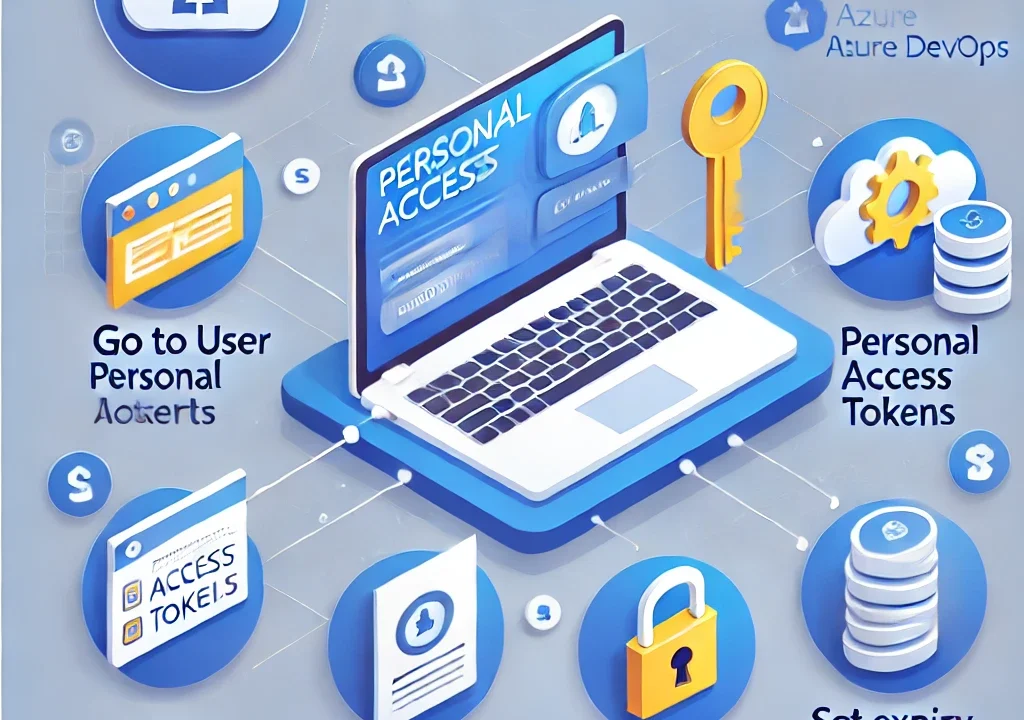How to Generate a Personal Access Token (PAT) in Azure DevOps
A Personal Access Token (PAT) in Azure DevOps is used for authenticating API requests or accessing repositories, pipelines, and other resources programmatically. It’s especially useful when performing automated tasks like CI/CD pipelines, Git operations, or using Azure DevOps REST APIs.
Here’s how to generate a Personal Access Token (PAT) in Azure DevOps.
Why Generate a PAT in Azure DevOps?
You may need a PAT to:
- Authenticate to Azure DevOps services without using your Azure account credentials.
- Access repositories, CI/CD pipelines, or other resources from external tools or scripts.
- Grant different levels of access (read, write, manage) to Azure DevOps services for automation or integration.
Prerequisites
- You need to have access to an Azure DevOps account.
- Ensure that you have the necessary permissions to create a PAT (usually, you need to be a member of a project or organization with appropriate permissions).
Steps to Generate a Personal Access Token (PAT) in Azure DevOps
1. Sign in to Azure DevOps
- Go to the Azure DevOps portal at https://dev.azure.com.
- Sign in with your Azure DevOps account credentials.
2. Navigate to User Settings
- In the top-right corner of the page, click on your profile icon or avatar.
- From the dropdown, select Security. This will take you to the Personal Access Tokens page.
3. Click on “New Token”
- On the Personal Access Tokens page, click on the New Token button to create a new PAT.
4. Configure the PAT
In the New Token dialog, configure your PAT as follows:
- Name: Give your PAT a descriptive name (e.g.,
CI/CD Automation Token). - Organization: Choose the Azure DevOps organization that you want the PAT to have access to.
- Expiration: Select an expiration period for your token (e.g., 30 days, 90 days, etc.). You can set it to never expire, but it’s a good practice to set an expiration for security reasons.
- Scopes: Select the permissions (scopes) you want the PAT to have. Common scopes include:
- Code: Read or write access to repositories.
- Build: Access to build pipelines.
- Release: Access to release pipelines.
- Project and Team Administration: To manage project and team settings.
- Work Items: Access to work items, boards, and queries.
You can choose Full Access for all permissions or pick specific ones depending on what the PAT is needed for.
5. Generate the Token
- Once you’ve configured the token, click Create.
- A Personal Access Token will be generated and displayed on the screen.
- Copy the token immediately after creation. This is the only time you’ll be able to see the token. Store it securely (e.g., in a password manager), as you won’t be able to retrieve it again once you navigate away from this page.
6. Use the PAT for Authentication
- You can now use your PAT to authenticate to Azure DevOps services. For example, you can use it for Git operations or in CI/CD pipelines.
- For Git, you can use it in place of your password when cloning, pulling, or pushing to a repository:
git clone https://<organization>.visualstudio.com/<project>/_git/<repo-name>When prompted for a password, use the PAT instead of your Azure DevOps password.
Managing Your Personal Access Tokens (PAT)
- Revoking a PAT: If you no longer need a PAT or suspect it’s been compromised, you can revoke it at any time from the Personal Access Tokens page.
- Creating Multiple PATs: You can create multiple PATs with different scopes for different tasks (e.g., one for CI/CD pipelines and another for Git operations).
- Changing Scopes: You cannot modify a PAT’s scopes after it’s created. If you need to change the scopes, you must create a new PAT.
Security Considerations
- Store Tokens Securely: Always store your PAT in a secure location, such as a password manager, and never expose it in your codebase.
- Use Minimum Required Permissions: Grant only the permissions needed for the task to follow the principle of least privilege.
- Set Expiration: Set an expiration date for your PATs to limit their lifetime, especially for temporary or automation tasks.
- Monitor Usage: Periodically review your PATs and revoke any that are no longer needed.
Conclusion: Generating a PAT in Azure DevOps
Generating a Personal Access Token (PAT) in Azure DevOps is essential for automating processes, authenticating through APIs, and working with repositories or pipelines in a secure way. By following the steps above, you can create a PAT that suits your specific needs, whether it’s for CI/CD automation or accessing code repositories.
You can also Contact OpsNexa for Devops architect and devops hiring solutions.



